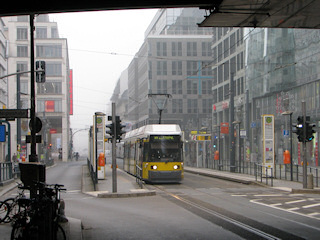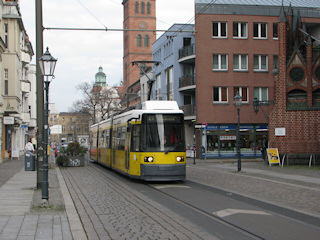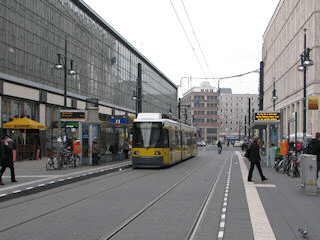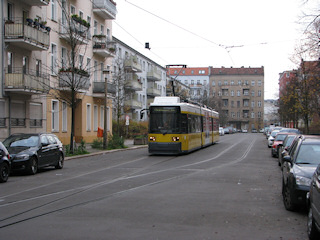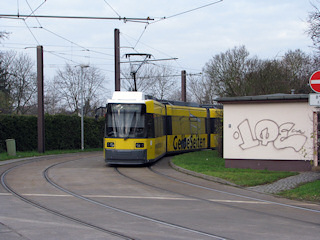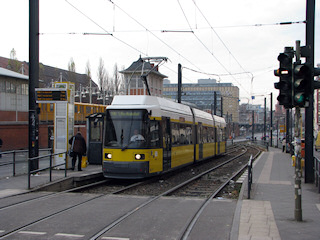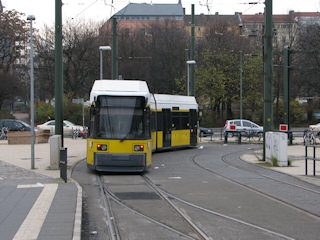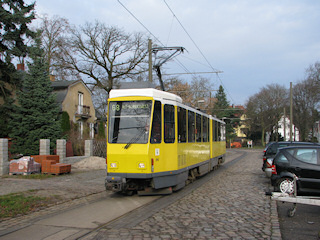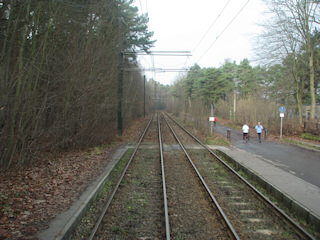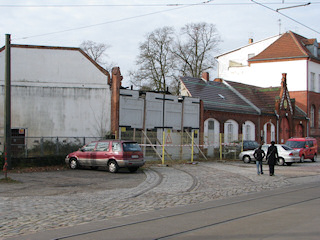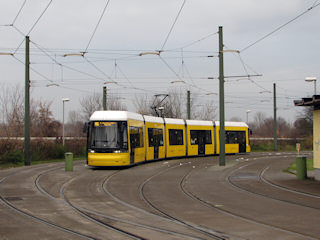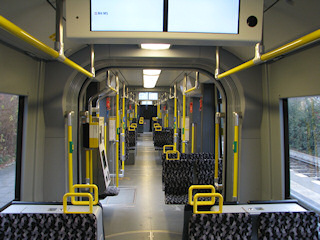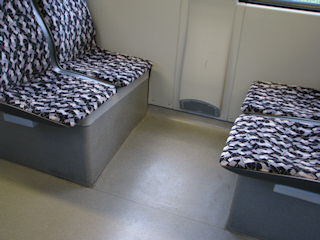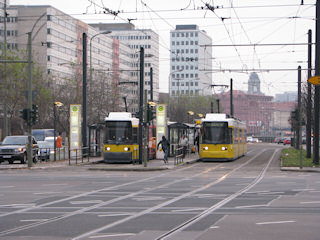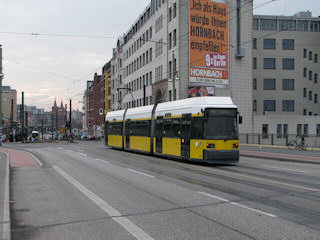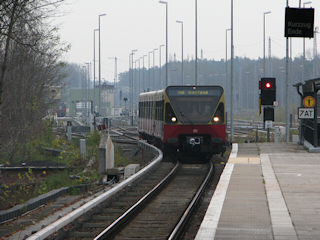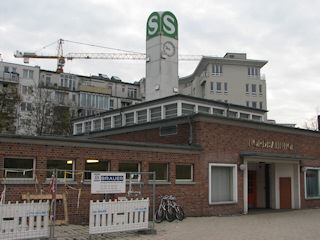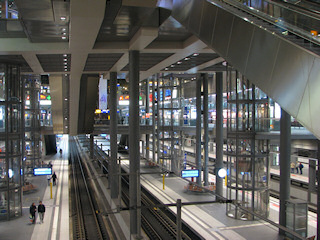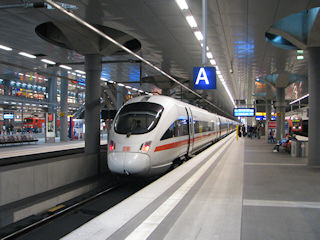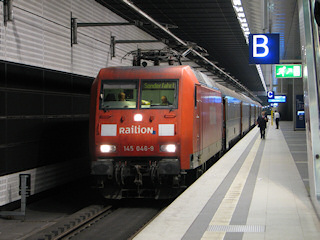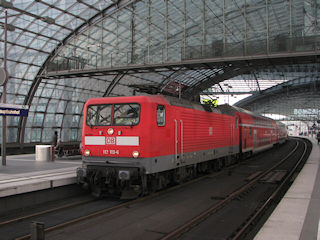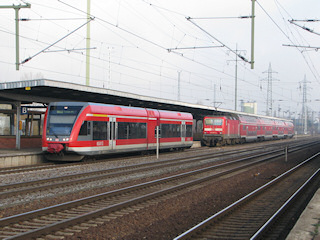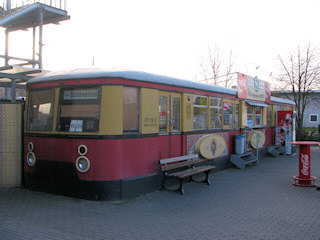budapest
other hungarian
close-up
lost rails
other countries
Berlin's trams and trains, November 2010
Originally I went to Germany's capital with a friend to get to know the trams of Berlin better, but somehow - with bad weather playing a big role in the decision - I ended up riding the fabulous U-Bahn system for most of the time. Nevertheless, I still managed to explore some unknown (for me, that is) tram territories thanks to Mr. Harald Tschirner, who acted as our guide.
Adtranz GT6N low-floor trams at Friedrichstrasse station (left) and in K÷penick (right). Although these trams are not new anymore, I still like them.
Alexanderplatz used to be modern center of Berlin, and as someone who has been brought up in the "Eastern Bloc", I've often read about it in school-books, because it was a well-advertised show-off place for the East-German way of life. Interestingly there were no trams there in those times. Then, in 1998, a line was built through the square, leading to the south-east side of the railway station (seen on the left, passing under the railway's tracks). After that (in 2007) more tram tracks were installed, this time on the other side of the station (right). This new track alignment currently acts as a stub terminus, and only one of the tracks is connected to the tram tracks running through Alexanderplatz.
Until 2000, Berlin's tram termini used to have reversing loops. These were and are used by unidirectional trams. To the left: Schwartzkopffstrasse, to the right Mahlsdorf.
Stub termini were introduced to enable having termini where place was scarce (or too expensive). For these, bidirectional vehicles were bought. To the left: Warschauer Strasse, with the terminus of U1 in the background, to the right: Nordbahnhof.
A short video of Berlin's tram life.
Line 68 leading to Alt-Schm÷ckwitz has a quite special route: it starts through small-town districts, then runs through forests along a row of lakes until it arrives to a quiet old village. Due to environmental regulations, parts of the line should be rebuilt soon, but it's not known yet, where the funding of this will come from, because the transportation company thinks it's unfeasible to spend so much money on a line with low patronage.
To the left: there's a small car-barn next to the Alt-Schm÷ckwitz terminus, used by tramway enthusiasts until 2006. It burnt down in 2008, with one old tramway car still in there :( To the right: the interior of a Tatra KT4D tramcar.
A short compilation of KT4D trams around the city. Although their replacement is on the way, there's more than two hundred of them still in use.
This replacement will be Bombardier's Flexity Berlin, a kind-of improved and tailor-made version of the Adtranz Incentro. When we were there, only four prototypes were in use: a short and a long unidirectional vehicle (GT6-08ER and GT8-08ER) and a short and long bidirectional (GT6-08ZR and GT8-08ZR).
The short bidirectional car at Alexanderplatz (left) and Zingster Strasse.
A short video of the ride with this vehicle. It's short, because the tram was so full of passengers, that it was impossible to see anything of the tram...
Two interior shots.
To the right: a "normal" and a refurbished GT6N at Mollstrasse/Otto-Braun-Strasse. To the right: a GT6N-ZR on Warschauer BrŘcke.
Railways are also vital to the public transit of Berlin. Although there are technical problems narrowing the services, the S-Bahn is still a remarkable transportation mean! To the left: a Class 480 train arriving to GrŘnau. To the right: the Nordbahnhof station of the north-south tunnel stretch, built in 1936.
40 seconds of Berlin S-Bahn. I wanted to take much more footage, but then I ran out of memory cards :-/
The new Berlin Central Station
Berlin's new Hauptbahnhof might be a prestige project, but it's very impressive. I'm not that much into railways, but I could have gladly spent hours just watching the traffic here!
The station looks like a spacious shopping mall with two levels of railway tracks at right angles. The low (in fact underground) floor (seen on these photos) has 8 tracks.
An ICE-T high-speed train (left) and a more traditional, engine-hauled international express (right) on the lower tracks.
A few minutes of trainspotting at this fabulous station.
The upper floor. Two tracks belong to the S-Bahn (these only have third (conductor) rails, and no catenary), four others are used by "normal" trains.
And some more Berlin trains.
At the end of the page: two photos taken near the Sch÷nefeld airport. To the left: a regional diesel train (Bombardier/Stadler GTW4/6) and a locomotive-hauled train with double-decker cars waiting on the same track. To the right: a buffet built out of a Class 277 S-Bahn train, right next to the airport.
Back to the top Back to the main page
